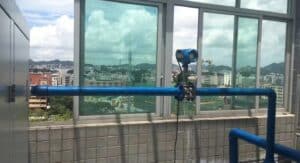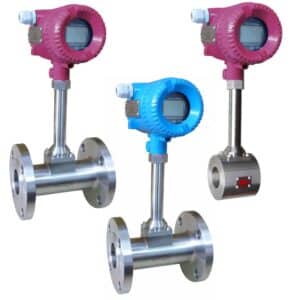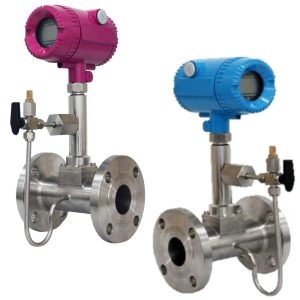Featured Products
SmartMeasurement offers two advanced vortex flow meter models designed to meet diverse industrial needs:
The ALVT provides reliable, maintenance-free operation with long service life, even in challenging environments with dirty or contaminated media. It excels in steam measurement, offering a cost-effective and easy-to-install solution compared to alternative technologies.
- ½-12" (15-300 mm)
- -23~482 °F ( -5 ~ +250 °C)
- 1.5% gas/steam, 1% liquids
- 1 to 10 cSt
- Up to 920 psi (6.4MPa)
- SS #304 (standard) SS #316 (optional)
- 4-20mA, pulse, Modbus, HART
- Flanges (ANSI, DIN & JIS), Wafer
- Steam, liquid, gas
- Best solution for steam, limited liquid and gas applications
The ALVT-Mass incorporates integrated pressure and temperature sensors for enhanced accuracy in dynamic conditions. It’s ideal for applications with fluctuating process conditions, providing precise mass flow measurements for gasses and steam.
- ½-12" (15-300 mm)
- -23~482 °F ( -5 ~ +250 °C)
- 1.5% gas/steam, 1% liquids
- 1 to 10 cSt
- Up to 920 psi (6.4MPa)
- SS #304 (standard) SS #316 (optional)
- 4-20mA, pulse, Modbus, HART
- Flanges (ANSI, DIN & JIS), Wafer
- Steam, liquid, gas
- Best solution for steam, limited liquid and gas applications
Vortex Flow Meters Overview
Vortex flow meters are innovative devices that measure fluid flow by detecting vortices created as fluid passes a bluff object. These meters excel in measuring liquids, gasses, and steam, including compressed air and saturated steam, without moving parts. Vortex flow meters offer reliability and low maintenance across various industrial applications, from oil and gas to power generation.
Vortex flow meters operate on the principle of vortex shedding, a phenomenon first observed by Theodore von Kármán. When fluid flows around a non-streamlined object (bluff body) in the meter, it creates alternating vortices. The frequency of these vortices is directly proportional to the fluid’s flow velocity, allowing for accurate flow measurement across a wide flow range.
Key Features of Vortex Flow Meters Include:
- Versatility: Capable of measuring various fluids, including compressed air and saturated steam
- Accuracy: Provides precise measurements for consistent performance
- Durability: No moving parts, resulting in low wear and maintenance
- Stability: Low sensitivity to variations in process conditions
- Cost-effectiveness: Offers a balance of performance and affordability
The vortex-shedding principle is observable in nature, such as wind creating ripples in a flag. In industrial settings, this principle is harnessed within a closed piping system, where the vortex effect is contained and measured to determine flow rates.
Vortex flow meters are particularly valuable in applications where introducing moving parts could be problematic. Their robust design, typically featuring stainless steel or Hastelloy construction, makes them suitable for harsh industrial environments.
Features and Benefits of Vortex Flow Meters
Vortex flow meters offer unique features that translate into significant benefits for various industrial applications:
- Versatile Fluid Compatibility: Measures liquids, gasses, and steam. All though steam is the primary application as other fluids have many other options
- No Moving Parts Design: Simple, robust construction ensures long-term reliability
- High Accuracy: Typical accuracy of ±0.5% to 1% for liquids and ±1% to 2% for gasses and steam
- Wide Turndown Ratio: Allows accurate measurement across a broad flow range
- Low Pressure Drop: Maintains system efficiency in the flow path
- Advanced Diagnostics: Many modern vortex flow meters offer built-in diagnostics
- Multivariable Measurement Options: Some models, known as multivariable vortex flow meters such as the Smartmeasurement ALVT-Mass which provide direct mass flow measurement for gasses and steam
By combining these features and benefits, vortex flow meters offer a robust and versatile solution for many flow measurement challenges across various industries. Their design principles ensure accurate, reliable performance with minimal maintenance, making them a cost-effective choice for long-term operations.
Applications and Limitations
Vortex flow meters offer versatile solutions for flow measurement across various industries. They excel in measuring natural gas,various liquids that have low viscosities, corrosive chemicals, solvents, and steam flow. Vortex flow meters are particularly useful for monitoring boiler efficiency and measuring compressed air and saturated steam in industrial processes.
Industrial Applications
- Oil and Gas: Vortex meters excel in measuring natural gas, steam for their boilers.
- Chemical Processing: These meters are widely used for measuring corrosive chemicals and solvents due to their robust construction and minimal moving parts.
- Power Generation: In power plants, vortex meters accurately measure steam flow, crucial for monitoring boiler efficiency and overall plant performance.
- Food and Beverage: The sanitary design of some vortex meters makes them suitable for measuring flows in food processing, particularly for clean liquids and steam.
- Water and Wastewater: Municipalities and treatment plants use vortex meters for measuring water flow in distribution systems and treatment processes.
Advantages in Application
- Wide Rangeability: Typically offering a turndown ratio of 20:1 or better
- Low Maintenance: Minimal upkeep due to lack of moving parts
- Accuracy in Varying Conditions: Maintains accuracy across changes in temperature and pressure
Limitations and Challenges
- Low Flow Cutoff: Struggles to measure very low flow rates accurately
- Vibration Sensitivity: External vibrations can interfere with vortex detection
- Straight Pipe Requirements: Needs significant straight pipe runs for optimal performance
- Limited Use with High-Viscosity Fluids: Accuracy decreases as fluid viscosity increases
- Pressure Drop: The presence of the bluff body in the flow path creates a pressure drop, which may be undesirable in some low-pressure systems
By carefully considering these applications and limitations, engineers and plant managers can determine whether a vortex flow meter is the right choice for their specific measurement needs. When properly applied, these meters offer reliable, low-maintenance flow measurement solutions across a wide range of industrial processes, from high-pressure pipeline monitoring to precise steam flow measurement in power plants.
Installation and Maintenance
Proper installation and maintenance are crucial for ensuring optimal performance and longevity of your vortex flow meter. Key considerations include:
- Choosing the right location with minimal turbulence
- Ensuring proper orientation and alignment
- Regular inspections and cleaning
- Periodic calibration checks
- Firmware updates for enhanced performance
Optimal Installation Practices
- Choose the Right Location: Select a straight pipe section with minimal turbulence. Aim for at least 10 pipe diameters of straight run upstream and 5 pipe diameters downstream from the meter.
- Consider Flow Path: Ensure the vortex flow meter is installed in a section where the flow path is fully developed and stable.
- Proper Orientation: Install the meter according to the manufacturer’s specifications, paying attention to flow direction indicators.
- Avoid Vibration: Mount the meter securely to minimize external vibrations that could affect vortex formation.
- Account for Pressure Drop: Consider the pressure drop introduced by the meter when designing your system.
Routine Maintenance Tips
- Regular Inspections: Conduct visual inspections of the meter and surrounding piping periodically to check for any signs of wear or damage.
- Clean Sensor: Keep the vortex sensor clean and free from buildup that could interfere with vortex detection.
- Check Signal Quality: Monitor the signal quality regularly. A weak or erratic signal may indicate issues with vortex formation or detection.
- Verify Calibration: Perform periodic calibration checks to ensure continued accuracy across the flow range. Follow the manufacturer’s recommended calibration schedule.
- Update Firmware: Keep the meter’s firmware up-to-date to benefit from the latest features and performance improvements.
Troubleshooting Common Issues
- Low Flow Readings: Check for partial blockages or buildup on the bluff body.
- Erratic Readings: Look for sources of external vibration or pulsating flow.
- Zero Flow Reading: Verify that the pipe is full and that the flow rate is above the meter’s minimum detection threshold. By following these installation and maintenance guidelines, you can ensure your vortex flow meter provides accurate and reliable measurements for years to come. Regular care and attention will maximize the meter’s performance and extend its operational life.
Sizing and Rangeability
Proper sizing and understanding the rangeability of vortex flow meters are crucial for ensuring accurate and reliable flow measurements. Rangeability, also known as turndown ratio, refers to the ratio between the maximum and minimum measurable flow rates of a vortex flow meter.
Understanding Rangeability
Rangeability, also known as turndown ratio, refers to the ratio between the maximum and minimum measurable flow rates of a vortex flow meter. A higher rangeability allows for accurate measurements across a wider range of flow rates, making the meter more versatile. Selecting a meter with appropriate rangeability is essential for optimizing performance in applications with varying flow conditions.
Typical Rangeability for Vortex Flow Meters
- For gases and steam: Up to 20:1
- For low-viscosity liquids: Over 10:1
Factors Affecting Rangeability
- Fluid Viscosity: Vortex meters are most effective with fluids below 30 centipoise
- Reynolds Number: Accuracy diminishes at lower Reynolds numbers, typically below 20,000
- Fluid Velocity: A minimum velocity is required to generate measurable vortices
Sizing Considerations
- Pipe Size: Choose a meter size that matches your pipe diameter
- Flow Range: Ensure expected flow rates fall within the meter’s specified range
- Pressure Drop: Consider allowable pressure drop when selecting a meter size
Best Practices for Sizing
- Determine the minimum and maximum flow rates for your application, including potential future changes.
- Calculate the Reynolds number for your fluid at these flow rates to ensure they fall within the meter’s accurate measurement range.
- Select a meter size that provides accurate readings across your flow range while maintaining acceptable pressure drop.
- Consider future flow rate changes or expansions in your sizing calculations to ensure long-term suitability.
By carefully considering these factors, you can select a vortex flow meter that provides accurate measurements across your required flow range, ensuring optimal performance in applications involving compressed air, saturated steam, and other fluids.
How Vortex Flow Meters Work
Vortex flow meters utilize the Von Kármán Effect to measure flow rates with remarkable accuracy. This principle describes the oscillating pattern of vortices created when fluid flows past a bluff object in the flow path. The process works as follows:
The Von Kármán Effect
Vortex flow meters utilize the Von Kármán Effect to measure flow rates with remarkable accuracy. This principle describes the oscillating pattern of vortices created when fluid flows past a bluff object in the flow path.
The process works as follows:
- Bluff Body Placement: A bluff body is positioned in the flow path within the meter.
- Vortex Formation: As fluid flows around this obstacle, it creates alternating vortices.
- Frequency Measurement: The frequency of vortex shedding is directly proportional to the fluid’s velocity.
- Flow Calculation: By measuring this frequency and knowing the pipe’s cross-sectional area, the vortex flow meter can calculate the volumetric flow rate.
The beauty of this method lies in its simplicity and reliability. The vortex shedding frequency remains consistent over a wide range of Reynolds numbers, making vortex meters highly accurate across a broad flow range. This consistency also means that vortex flow meters can measure liquids, gasses, and steam with equal effectiveness, a versatility that sets them apart in the world of flow measurement. Moreover, the lack of moving parts in vortex flow meters contributes to their durability and low maintenance requirements. The bluff body, being stationary, is less prone to wear and tear compared to mechanical components in other types of flow meters. Understanding the Von Kármán Effect and its application in vortex flow meters is crucial for appreciating the technology’s strengths and selecting the right meter for specific industrial applications. Whether it’s monitoring steam in power plants, measuring natural gas in pipelines, or controlling chemical processes, vortex flow meters leverage this fundamental principle of fluid dynamics to provide reliable, accurate flow measurement.
Theories of Operation

Vortex flow meters’ principle of operation is based on the work of early 20th-century Hungarian-American physicist Theodore von Karman. Von Karman discovered that when a non-streamlined obstruction (also referred to as a bluff body) is placed in the path of a flowing media, the fluid will alternately separate from the object on its two downstream sides. As this phenomenon occurs, the boundary layer becomes detached and curls back on itself and the fluid forms vortices (also called whirlpools or eddies). Von Karman also noted that the distance between the vortices was constant and depended solely on the size and geometry of the bluff body causing the vortices’ to be formed.

The frequency of the vortex formation and shedding depends on several factors: velocity of the fluid (V), width of the shedder (d), and Reynolds number (Re). The relationship of velocity with flow and frequency can be given as f = S × V/d, where S is the Strouhal number.
Bluff body geometries (square, rectangular, t-shaped, trapezoidal) and dimensions will vary from manufacturer to manufacturer; these design differences will provide for certain performance trade-offs. The bluff body’s width must occupy a large enough portion of the overall pipe diameter that the entire flow profile will participate in the vortex shedding process. It also must have protruding edges on the upstream face in order to fix the lines of flow separation, regardless of the flow rate. The bluff body’s length along the direction of the flow must be a certain minimum multiple of the bluff body width.
When fluids pass through a bluff body on the side of the bluff body where the vortex is initially formed, fluid velocity is higher, and pressure is lower. As the vortex moves downstream, it grows in strength and size, and then eventually detaches or sheds itself. (This is why vortex meters are sometimes referred to as vortex shedding meters.) Alternating vortices are formed on each side of the bluff body 180 degrees apart and are spaced at equal distances. In fluid mechanics, these vortices are referred to as a Karman Vortex Street. The frequency with which the vortices are formed, as well as the magnitude & length of the vortices, are directly proportional to the velocity of the flowing media. The animation below illustrates this phenomenon. This phenomenon can also be observed as wind hits a flagpole and the flag moves from side to side. In this analogy, the flagpole acts as a bluff body causing the vortex formation and the rippling of the flag is the response to the vortices’ formation. In a closed pipe, the vortex effect is dissipated within a few pipe diameters downstream of the bluff body. The vortex meter counts the vortices in much the same way that a turbine flow meter counts rotations of a turbine’s blades, by making use of commonly available electronic components such as a piezoelectric sensor.


There are a number of different ways that a vortex meter may detect and count the vortices’ formation. The majority of vortex meters use piezoelectric or capacitance-type sensors which detect the pressure oscillation around the bluff body. The sensor detects pressure oscillation with a low voltage output signal which has the same frequency as the oscillation. These replaceable sensors can operate over a wide range of temperatures in order to accommodate all types of flow measurement applications ranging from cryogenic liquids to superheated steam. Sensors can be located inside or outside of the bluff body. Wetted sensors (outside the bluff body) sense the vortex pressure fluctuations and are enclosed in hardened cases to avoid corrosion and erosion effects. External sensors, typically piezo-electric strain gages, sense the vortex shedding indirectly through the force exerted on the shedder bar. External sensors are preferred for highly erosive/corrosive applications in order to reduce maintenance costs, while internal sensors provide better rangeability and low flow sensitivity. The internal sensor is also less sensitive to interference from ambient pipe vibrations.
The primary materials of construction for the Vortex flowmeter are typically either 304 or 316 stainless steels. Components fabricated from the stainless alloy would include the flow body, the bluff body, and the flanged process connections. Other key components include the sensor which counts the vortices, which is typically a piezoelectric type, and a display/transmitter module which can be mounted integrally or remotely. The vortex meter is typically offered as an inline meter with either flanged or wafer-type process connections, but it may also be provided as an insertion style probe. Vortex meters are sensitive to low Reynolds numbers and to velocity profile distortion.
.
Vortex Flow Meters | Smartmeasurement Inc.

Vortex flow meters for measuring liquid, gas, and steam. Enhance process control and reliability with SmartMeasurement's efficient, maintenance-free solutions.
Product In-Stock: InStock


